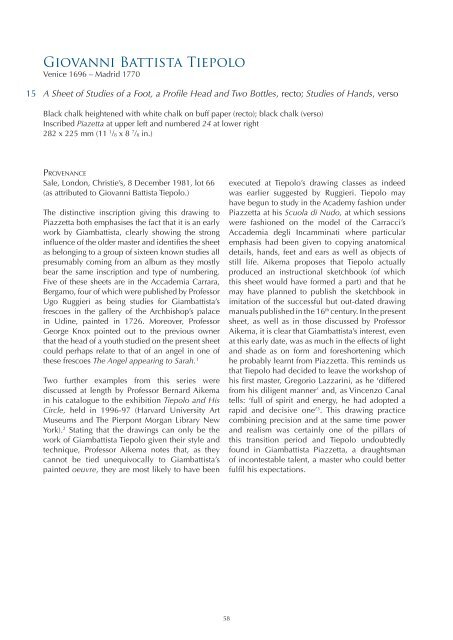XV - Works On Paper - Marty de Cambiaire (English)
Create successful ePaper yourself
Turn your PDF publications into a flip-book with our unique Google optimized e-Paper software.
Giovanni Battista Tiepolo<br />
Venice 1696 – Madrid 1770<br />
15<br />
A Sheet of Studies of a Foot, a Profile Head and Two Bottles, recto; Studies of Hands, verso<br />
Black chalk heightened with white chalk on buff paper (recto); black chalk (verso)<br />
Inscribed Piazetta at upper left and numbered 24 at lower right<br />
282 x 225 mm (11 1 /8 x 8 7 /8 in.)<br />
PROVENANCE<br />
Sale, London, Christie’s, 8 December 1981, lot 66<br />
(as attributed to Giovanni Battista Tiepolo.)<br />
The distinctive inscription giving this drawing to<br />
Piazzetta both emphasises the fact that it is an early<br />
work by Giambattista, clearly showing the strong<br />
influence of the ol<strong>de</strong>r master and i<strong>de</strong>ntifies the sheet<br />
as belonging to a group of sixteen known studies all<br />
presumably coming from an album as they mostly<br />
bear the same inscription and type of numbering.<br />
Five of these sheets are in the Acca<strong>de</strong>mia Carrara,<br />
Bergamo, four of which were published by Professor<br />
Ugo Ruggieri as being studies for Giambattista’s<br />
frescoes in the gallery of the Archbishop’s palace<br />
in Udine, painted in 1726. Moreover, Professor<br />
George Knox pointed out to the previous owner<br />
that the head of a youth studied on the present sheet<br />
could perhaps relate to that of an angel in one of<br />
these frescoes The Angel appearing to Sarah. 1<br />
Two further examples from this series were<br />
discussed at length by Professor Bernard Aikema<br />
in his catalogue to the exhibition Tiepolo and His<br />
Circle, held in 1996-97 (Harvard University Art<br />
Museums and The Pierpont Morgan Library New<br />
York). 2 Stating that the drawings can only be the<br />
work of Giambattista Tiepolo given their style and<br />
technique, Professor Aikema notes that, as they<br />
cannot be tied unequivocally to Giambattista’s<br />
painted oeuvre, they are most likely to have been<br />
executed at Tiepolo’s drawing classes as in<strong>de</strong>ed<br />
was earlier suggested by Ruggieri. Tiepolo may<br />
have begun to study in the Aca<strong>de</strong>my fashion un<strong>de</strong>r<br />
Piazzetta at his Scuola di Nudo, at which sessions<br />
were fashioned on the mo<strong>de</strong>l of the Carracci’s<br />
Acca<strong>de</strong>mia <strong>de</strong>gli Incamminati where particular<br />
emphasis had been given to copying anatomical<br />
<strong>de</strong>tails, hands, feet and ears as well as objects of<br />
still life. Aikema proposes that Tiepolo actually<br />
produced an instructional sketchbook (of which<br />
this sheet would have formed a part) and that he<br />
may have planned to publish the sketchbook in<br />
imitation of the successful but out-dated drawing<br />
manuals published in the 16 th century. In the present<br />
sheet, as well as in those discussed by Professor<br />
Aikema, it is clear that Giambattista’s interest, even<br />
at this early date, was as much in the effects of light<br />
and sha<strong>de</strong> as on form and foreshortening which<br />
he probably learnt from Piazzetta. This reminds us<br />
that Tiepolo had <strong>de</strong>ci<strong>de</strong>d to leave the workshop of<br />
his first master, Gregorio Lazzarini, as he ‘differed<br />
from his diligent manner’ and, as Vincenzo Canal<br />
tells: ‘full of spirit and energy, he had adopted a<br />
rapid and <strong>de</strong>cisive one’ 3 . This drawing practice<br />
combining precision and at the same time power<br />
and realism was certainly one of the pillars of<br />
this transition period and Tiepolo undoubtedly<br />
found in Giambattista Piazzetta, a draughtsman<br />
of incontestable talent, a master who could better<br />
fulfil his expectations.<br />
58
















